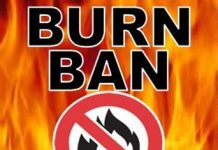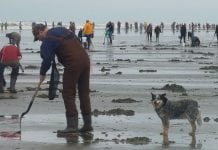Memorial Day honors and mourns those who have died while serving in the U.S. military. After the Civil War people across the nation began gathering to decorate the graves of soldiers killed in the conflict. Eventually Union veteran organizations decided to conduct these ceremonies on May 30, a date not associated with any battle. Originally called “Decoration Day,” it was later renamed Memorial Day. Grays Harbor veterans brought the holiday with them to the Pacific Northwest.
Memorial Day in Grays Harbor
Memorial Day was an important holiday for veterans locally. Although Washington was far away from the Civil War, many veterans moved here in the decades following. Grays Harbor County was home to several posts of the Grand Army of the Republic, a Union veterans’ organization. These were Aberdeen’s George CookPost No. 68, Hoquiam’s Washington Post No. 52, Cosmopolis’ W.S. Hancock Post No. 43, Elma’s Worthington Post No. 81 and Montesano’s James A. Garfield Post No.13.
Wives and daughters of veterans could join the Woman’s Relief Corps, the Grand Army of the Republic’s female auxiliary. Membership in this group was more flexible, and Woman’s Relief Corps still exists, unlike the Grand Army of the Republic, which closed after the Civil War generation died out. At the turn of the century, the local Woman’s Relief Corps often served lunch to veterans on Memorial Day and collected flowers to decorate graves.
Honoring Memorial Day in Grays Harbor
The Grand Army of the Republic led local Memorial Day commemorations, often coming together to hold a public county-wide celebration in Aberdeen or Hoquiam, inviting all “old soldiers,” not just Grand Army of the Republic members. Stores and businesses closed for the day, decorating their windows with flags and bunting. Schools held patriotic exercises and students were free to join the parade and ceremonies.
The 1893 celebrations are a good example of a typical Memorial Day. Grand Army of the Republic groups from across the county gathered at the Grand Army of the Republic Hall in Aberdeen. Led by a band, they marched in a parade to the foot of Wishkah Street where they boarded the steamer Clan McDonald for a short trip to Fern Hill Cemetery. There they decorated the graves of veterans with flowers and flags. That year, Reverand A.H. Lackey, who had been a chaplain in the Civil War, spoke. His wife sang. “One of the tenderest memories of the day was the tribute paid by the band boys,” reported the Aberdeen Herald, “to the memory of their departed comrade, Walter Sargent, whose grave they covered with flowers.” Over 500 attended despite the misty weather.
Memorial Day services were also held at local churches or in rented halls and theaters. These gatherings included patriotic music, recitations, and speeches from local and guest speakers. A reading of Lincoln’s Gettysburg Address was a popular choice. Another popular tradition was tossing flowers into the water in memory of those who had died at sea. In 1917, members of the Woman’s Relief Corp gathered on the Heron Street Bridge to do so.

Healing the Wounds of War
This period saw attempts to reconcile North and South. Although the public discourse often ignored or downplayed the issues that had caused the war, for veterans this could be a very different experience. Working with the same men they had formally fought against brought them the peace they needed to try to put the animosity of the Civil War behind them.
Charles Clay, a Confederate veteran who was “very popular with the boys in blue” spoke at a 1902 Elma event. Town marshal, he was killed in the line of duty three years later. Another popular veteran was Jacob Heater, who operated a ferry by the North Aberdeen bridge for the city. A Confederate veteran from Georgia, he often joined the Grand Army of the Republic for Memorial Day exercises. He even went with county Grand Army of the Republic representatives on a trip to Gettysburg in 1913, the 50th anniversary of the battle.
Through his work with the Grand Army of the Republic, Heater befriended Joseph Ingram, a Union veteran. A picture of them in their respective uniforms shaking hands was made. On Memorial Day 1913, three years after Ingram’s death from long-term complications of being poisoned during the war by Confederate sympathizers, Heater left a wreath and flag on his friend’s grave with the following note to his “old comrade,” writing that “The joyous watchword of fraternity throughout this land today is, ‘One flag and one country.’ While we opposed each other in legitimate conflict, we were friends in life. When mother nature has taken us back to her bosom in peaceful sleep may we clasp hands again.”
Memorial Day: A Changing Holiday
As the years wore on, the holiday changed. Civil War veterans were joined by younger veterans, from the 1898 Spanish American War. By the 1910s, these younger men took charge of Memorial Day exercises. Grand Army of the Republic members were now honored guests, driven in cars rather than walking along the parade route. World War I would later bring new attention to the day again.
Memorial Day only became a federal holiday in 1971. The date was changed from May 30 to the last Monday in May. Although Memorial Day has changed, it continues to honor those who have laid down their lives in service of their country.












































